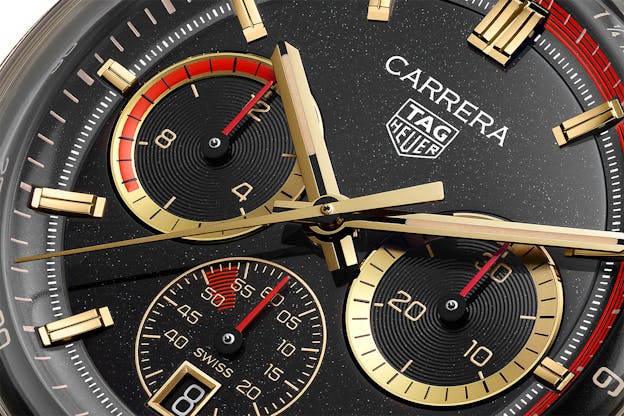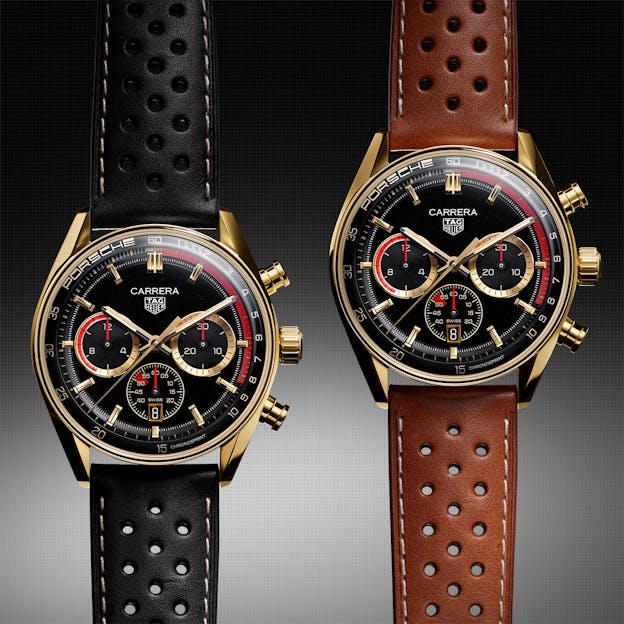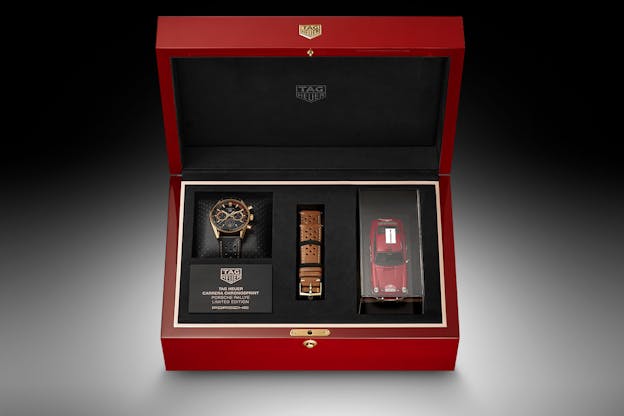LVMH Watch Week: The TAG Heuer Carrera Chronosprint x Porsche ‘Rallye,’ First Look, Live Photos
The latest versions of this unusual ‘chronosprint’ chronograph has a new, darkly handsome dial.
TAG Heuer introduced the first version of the Chronosprint in 2023 (I almost wrote, “last year” – I think I’m in denial about it being 2025) and it got a lot of tongues wagging, thanks to its unique take on the chronograph complication. The Chronosprint has a center chronograph seconds hand that does something I don’t think any chronograph had ever done before – it runs at different speeds depending on where the hand is in the timing cycle.

As you can see, the chronograph seconds track has a red sector covering a little over the first 120º of the scale. The chronograph seconds hand starts off running very fast, passing through that sector in 8.2 seconds. As it reaches the end of the sector, it begins to slow down – when it reaches 6:00 on the dial, a total of fifteen seconds have elapsed; 30 seconds have elapsed when the hand reaches 9:00 and it continues to decelerate until by the time it reaches 12:00, 60 seconds have elapsed, as would be the case in a conventional chronograph.
The reason for this has to do with the fact that the watch is a collaboration with Porsche, and specifically, it’s a mechanical shout-out to the history of the 911. The first version of this watch had a seconds hand that ran fastest during the first 9.1 seconds, which was the 0-100 kilometers per hour time of the first 911. For the Rallye model, the hand covers that interval in 8.4 seconds, which reflects the 0-100 kph time of the 1965 Porsche 911 “147” during the Monte Carlo Rally, or Rallye Monte-Carlo. This has taken place since 1911, in January, and since parts of the route go through the French Alps, driving conditions can often be hazardous, with anything from dry pavement to snow and everything in between. 1965 was the first year that the 911 participated in the Rally and the two man Porsche team were a couple of motorsports legends. The driver was engineer Herbert Linge, who in addition to his racing career was also a stunt driver in the Steve McQueen film, “Le Mans.” The co-driver was Porsche Racing Director Vehicle Development, Peter Falk, who worked at Porsche for over 30 years, having joined the company in 1959. The route had heavy snow that year and of the 237 teams who started, only 22 made it to the finish in the South of France.

The chronograph system in the Chronosprint raised more than a few eyebrows when it was introduced but in practice, it is straightforward to use and read – some enthusiasts opined that it was not a practical chronograph but aside from the Chronosprint complication, it is a straightforward three register automatic chronograph with date. The markers are closer and closer together as they go around the dial, but this does make precise read-off of the first ten seconds or so, actually easier than it is with a standard chronograph – you can think of the Chronosprint as a chronograph especially designed for precise timing of short intervals (as well as, of course, a mechanical homage to early 911 models).

The movement was designed by Carole Forestier-Kasapi, one of the most famous movement constructors in the industry (she was the one who came up with the design that eventually, with some modifications, became the Ulysse Nardin Freak and she was also behind the plethora of mid-2000s complications – including mystery tourbillons, exotic perpetual calendars, and more, produced at Cartier). When the first Chronosprint was announced, she gave an interview to Revolution explaining how it works, and if you’d like to see it in action, you can actually push virtual pushers and see the seconds hand do its thing at TAG Heuer’s website.

Other than an update to the “sprint” timing interval, the main difference between the new Rallye versions of the Chronosprint and the earlier ones are the dials, which TAG describes as “shimmery” – there is a very subtly sparkling surface on the dials which in photographs is difficult to capture and which I mistook at first glance for dust. The effect is easier to see in TAG Heuer’s press images.

As with the first version, the Rallye Chronosprint will be available in stainless steel or gold – both limited editions, the steel model will be made in a series of 911 watches and the gold model, only 11.


These are obviously aimed primarily at Porsche enthusiasts and 911 owners but I think that they’re a great example of out-of-the-box thinking in terms of chronograph design in general, and how to handle a collaboration in an imaginative way in general – so often with this sort of thing you see some perfunctory logo-ing and maybe if you’re lucky, a carbon fiber dial. On top of that, the price at least for the steel model is almost shockingly affordable, at least by modern luxury watch pricing standards; just CHF 10,000 in steel and CHF 24,000 in gold. I know I just said that these are aimed at 911 fans and owners and of course they are, but I don’t have a 911 (right now I don’t even have a driver’s license) and I’d still wear the hell out of this watch – it’s well made, technically clever, and a great conversation piece.
The 1916 Company is proud to be an authorized retailer for TAG Heuer.
The TAG Heuer Carrera Chronosprint x Porsche “Rallye,” references CBS2015.EB0381 (steel) and CBS2041.EB0382 (yellow gold): cases, 42mm x 14.9mm, 48.6mm lug to lug, with sapphire crystals front and back; water resistance 100M; black “shimmery” dial, and domed glassbox crystal. Movement, “chronosprint” chronograph complication, caliber TH20-08 automatic chronograph. Price, CHF 10,000 in steel or CHF 24,000 in gold; available immediately. For more, visit TAGHeuer.com.

